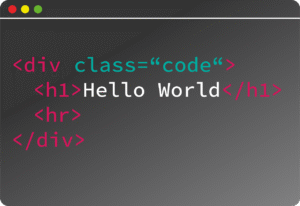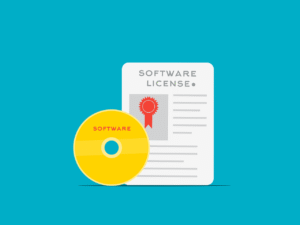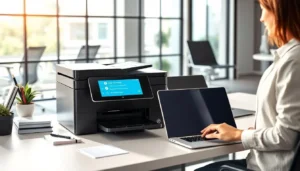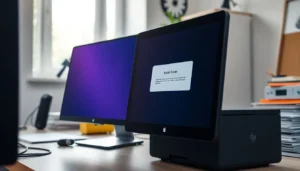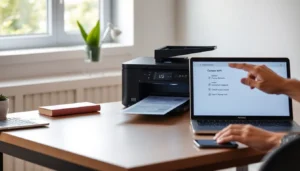Printer Online
Introduction
Nothing is more frustrating than trying to print an important document and seeing your printer stuck offline. It halts your work and can cause delays or stress. Luckily, most printer problems are easy to fix without calling tech support. This guide walks you through simple steps to troubleshoot and reconnect your printer online quickly and without extra cost. Whether you’re dealing with Wi-Fi or USB printers, these tips will help get your machine working again fast.
Understanding Why Printers Go Offline
Common reasons for printer offline status
Printers often show offline because of small issues. They might lose connection due to Wi-Fi glitches, outdated drivers, or setup errors. Sometimes the printer’s settings accidentally switch to offline, or the network gets busy. Power surges or hardware damage can also be culprits. Knowing what causes the offline message helps you target the fix.
The impact of offline printers on productivity
When your printer is offline, it can halt all printing jobs, slowing down your work. Studies show that small tech issues like printer downtime waste hours each week. It can also increase frustration, lowering focus. The good news: most offline problems are quick to solve, saving you time and stress.
When to seek professional help
If troubleshooting doesn’t work, it might be time for help. Signs include persistent errors after updates, physical damage, or complex network issues. If your printer still won’t connect after following these steps, expert support can prevent further delays.
Step 1: Check Physical Connections and Power Supply
Verify power connection and status light
First, make sure your printer is properly plugged in. Look for the power indicator light—if it’s off or blinking, there could be power issues. Sometimes, the outlet or power cord is the problem. Switch outlets or replace cables if needed.
Confirm cable connections
For USB printers, check the cable connecting the printer to your computer. For network models, ensure Ethernet cables are snug and correct. Loose or damaged cords will block communication. Testing with a different cable often fixes the problem.
Inspect for hardware issues
Look for loose wires, visible damage, or paper jams. If your printer has physical problems, it might fail to communicate with your device. Replacing damaged parts or calling a technician might be necessary if hardware fails.
Step 2: Restart and Reset Printer and Network Devices
Power cycle the printer
Turning the printer off and on can clear temporary glitches. Unplug it, wait about 30 seconds, then plug it back in. This simple reset often restores normal operation.
Restart the router and modem
Network issues are common culprits. Reboot your Wi-Fi router and modem to refresh internet connections. Wait until lights stabilize before testing your printer again.
Reboot connected devices (computers, tablets)
Sometimes, the device used to print needs a refresh. Restart your computer or tablet to clear any lingering connection problems. Reconnect to the network before trying again.
Step 3: Set Printer Online via Computer Settings
Access printer status on Windows
Open the Control Panel or Settings, then go to “Devices & Printers.” Find your printer and right-click. If it shows “Use Printer Offline,” click “Cancel all documents” and uncheck the offline setting.
Change printer status to online
In the same menu, confirm that “Use Printer Offline” is not selected. If it is, toggle it off. Reset the printer as default if needed. These steps push the printer back to active mode.
For Mac users
Open System Preferences, pick “Printers & Scanners,” then select your printer. Open the print queue and click “Resume” or “Set Online.” These simple steps get your printer back on track.
Step 4: Check and Update Printer Drivers and Firmware
Verify driver installation
Ensure the correct driver is installed. Sometimes, outdated or corrupted drivers cause offline errors. Remove old drivers via Device Manager and reinstall fresh versions from the manufacturer’s website.
Update drivers and firmware
Go to the printer’s brand website for the newest software updates. Installing the latest driver or firmware fixes bugs and improves connection stability. Follow the instructions carefully during installation.
Resolve driver conflicts
Avoid installing multiple drivers for different models. Conflicts can prevent your printer from working correctly. Remove unnecessary or conflicting driver software from your computer.
Step 5: Confirm Network Configuration
Assign correct IP address
Ensure your printer has a unique IP address. Use DHCP for automatic assignment to prevent conflicts. Static IPs work well if set properly; otherwise, conflicts cause offline issues.
Set printer as default network printer
Make sure your printer appears as the default printing device in printer settings. This avoids accidental selection of a non-connected or offline printer.
Troubleshoot wireless connectivity issues
Check your Wi-Fi signal strength—weak signals can cause disconnections. Reconnect the printer to your network or switch to Ethernet if possible for a more stable connection.
Step 6: Use Printer Troubleshooter Tools
Built-in troubleshooting utilities
Windows offers troubleshooting tools—run the troubleshooter from Settings → Update & Security → Troubleshoot → Printer. Follow the prompts to fix common problems.
Manufacturer-specific diagnostic tools
Visit your printer brand’s website for special diagnostics software. These tools can scan for issues and recommend specific fixes, saving you time.
Follow recommended solutions
Always read the troubleshooting suggestions carefully. Implement the fixes step-by-step to ensure your printer gets back online smoothly.
Conclusion
Getting your printer online doesn’t have to be complicated. Start by checking connections, restarting devices, and updating drivers. Most issues are solved by these basic steps, and routine maintenance can prevent future problems. Keep your printer updated and well-maintained to avoid offline headaches. With these easy tips, you’ll get back to printing in no time—and save yourself the cost of service calls or replacement. Regular checks and simple troubleshooting truly keep your workflow smooth and stress-free.




























































